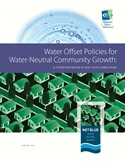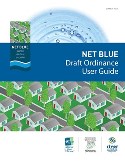Net Blue: Supporting Water-Neutral Growth

Net Blue is a collaborative initiative of the Alliance for Water Efficiency (AWE), the Environmental Law Institute (ELI), ![]() and River Network
and River Network ![]() to support sustainable community growth. The project team members developed a model ordinance that communities can tailor and customize to create a water demand offset approach meeting local needs. Communities in different regions throughout the United States were consulted to help develop the model ordinance and the offset components, and to ensure that the program is adaptable to many different political climates, legal frameworks, and environmental challenges.
to support sustainable community growth. The project team members developed a model ordinance that communities can tailor and customize to create a water demand offset approach meeting local needs. Communities in different regions throughout the United States were consulted to help develop the model ordinance and the offset components, and to ensure that the program is adaptable to many different political climates, legal frameworks, and environmental challenges.
The Net Blue Project is divided into four parts:
1. Initial Offset Research
 Report entitled, Water Offset Policies for Water-Neutral Community Growth,
Report entitled, Water Offset Policies for Water-Neutral Community Growth, ![]() which reviewed 13 communities throughout the United States that currently have a water demand offset policy or water neutral growth policy in place. These policies require offsetting the projected water demand of new development with water efficiency measures to create a “Net Zero” or neutral impact on overall service area demands and water use. The report found that the most common scenario where this has been applied entails issuing building permits for development that requires offset of the new water use through both on-site water efficiency measures and replacement of inefficient fixtures in pre-existing facilities. In numerous California communities and in cities ranging from Santa Fe, New Mexico to Sharon, Massachusetts, water demand offset programs have been utilized to help enable new construction that likely would have been prohibited due to supply constraints. The report also contains a literature review related to this topic, and information on communities that had a water demand offset policy in the past.
which reviewed 13 communities throughout the United States that currently have a water demand offset policy or water neutral growth policy in place. These policies require offsetting the projected water demand of new development with water efficiency measures to create a “Net Zero” or neutral impact on overall service area demands and water use. The report found that the most common scenario where this has been applied entails issuing building permits for development that requires offset of the new water use through both on-site water efficiency measures and replacement of inefficient fixtures in pre-existing facilities. In numerous California communities and in cities ranging from Santa Fe, New Mexico to Sharon, Massachusetts, water demand offset programs have been utilized to help enable new construction that likely would have been prohibited due to supply constraints. The report also contains a literature review related to this topic, and information on communities that had a water demand offset policy in the past.
2. Model Ordinance
 A template for a model ordinance that requires or incentivizes offsetting the impact of new development's water use via water efficiency measures. ELI led the work on developing the model ordinance. Building on AWE’s initial offset research report, ELI did the following: (1) Analyzed the legal language used in existing water offset ordinances; (2) Identified potentially useful supplemental language in other ordinances; (3) Assessed a variety of institutional configurations that may influence the adoption and implementation of a water offset ordinance; and (4) Examined legal opportunities for and constraints on expanding the concept to new places. The final work product resulted in a model ordinance worksheet, a user’s guide, and three examples of customized ordinances. Due to the variety of circumstances that occur in a county, municipality, or utility, and the diversity of legal constraints and authorities that can dictate the form of such an ordinance, a “one size fits all” approach does not work in this context. Thus, the model ordinance is in the form of a dynamic worksheet, developed in consultation with land use law experts, municipal planners, and experienced developers, to ensure its practicality, accuracy, and ease-of-use in customizing the ordinance for the needs of the community.
A template for a model ordinance that requires or incentivizes offsetting the impact of new development's water use via water efficiency measures. ELI led the work on developing the model ordinance. Building on AWE’s initial offset research report, ELI did the following: (1) Analyzed the legal language used in existing water offset ordinances; (2) Identified potentially useful supplemental language in other ordinances; (3) Assessed a variety of institutional configurations that may influence the adoption and implementation of a water offset ordinance; and (4) Examined legal opportunities for and constraints on expanding the concept to new places. The final work product resulted in a model ordinance worksheet, a user’s guide, and three examples of customized ordinances. Due to the variety of circumstances that occur in a county, municipality, or utility, and the diversity of legal constraints and authorities that can dictate the form of such an ordinance, a “one size fits all” approach does not work in this context. Thus, the model ordinance is in the form of a dynamic worksheet, developed in consultation with land use law experts, municipal planners, and experienced developers, to ensure its practicality, accuracy, and ease-of-use in customizing the ordinance for the needs of the community.
3. Offset Methodology
 An Excel spreadsheet to accompany the Model Ordinance to show methods for calculating water offsets. This tool is designed to help project applicants and municipal officials in determining the extent of the needed offsets and how an applicant might easily meet them. AWE led the development of this product. The Offset Methodology provides a user-friendly structure for calculating offsets from off-site water conservation retrofits, rainwater harvesting, and stormwater capture. The Offset Methodology can be used by planning and zoning staff, builder and developer applicants, lawyers, water utility staff, and others in the community. It is an Excel file that can be downloaded and used freely. The Offset Methodology can also be amended by the community to suit local conditions. All the calculations are open source.
An Excel spreadsheet to accompany the Model Ordinance to show methods for calculating water offsets. This tool is designed to help project applicants and municipal officials in determining the extent of the needed offsets and how an applicant might easily meet them. AWE led the development of this product. The Offset Methodology provides a user-friendly structure for calculating offsets from off-site water conservation retrofits, rainwater harvesting, and stormwater capture. The Offset Methodology can be used by planning and zoning staff, builder and developer applicants, lawyers, water utility staff, and others in the community. It is an Excel file that can be downloaded and used freely. The Offset Methodology can also be amended by the community to suit local conditions. All the calculations are open source.
4. Community Outreach
Outreach undertaken to communities, groups and professional associations around the country to get feedback on the Net Blue concept and how it might be applied in a variety of places. Feedback received informed the development of the final model ordinance toolkit. Seven geographically and environmentally diverse communities collaborated with the project team to review and test the concepts of the project. Over a two-year period the project team met with a variety of stakeholders including water utilities and managers, planners, developers, environmental and community groups in these communities to review and vet draft materials.
Click to request the Model Ordinance, User Guide, Offset Methodology, and example ordinances.
If you want to know more, AWE conducted a two-part webinar on the Net Blue Initiative. Click to view Part I, an overview of the project. Click for Part II, "Office Hours" which addresses common uses of the tools and answers frequently asked questions.
This project was made possible by a generous grants from the Rosin Fund of the Scherman Foundation, ![]() and the Turner Foundation.
and the Turner Foundation. ![]()





